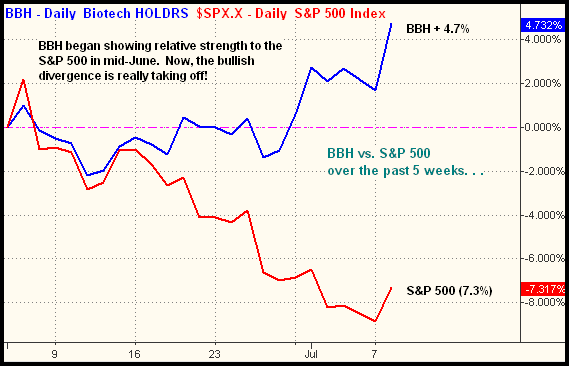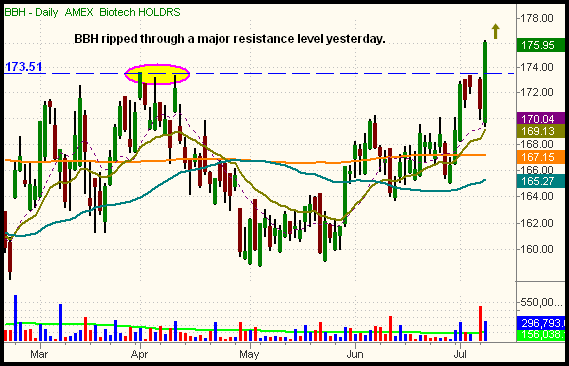|
The Wagner Daily ETF Report For July 9
The stock market staged a much-needed relief rally yesterday, as volume picked up across the board. After opening flat, the major indices chopped around in a sideways range throughout most of the session, but buyers stepped up to the plate in the final ninety minutes of trading. The Nasdaq Composite advanced 2.3%, the S&P 500 1.7%, and the Dow Jones Industrial Average 1.4%. Small caps took center stage, enabling the Russell 2000 Index to zoom 3.7% higher. The S&P Midcap 400 climbed 2.2%. Trending steadily north into the close, all of the major indices closed at their intraday highs.
Notably, higher turnover in both the NYSE and Nasdaq confirmed yesterday's broad-based gains. Total volume in the NYSE swelled 12%, while volume in the Nasdaq rose 6% above the previous day's level. The higher volume gains enabled both the S&P 500 and Nasdaq Composite to score a bullish "accumulation day," a rare event these days. The only slight negative was that relative weakness in a few industry sectors, such as energy, prevented market internals from being overly positive. In both exchanges, advancing volume exceeded declining volume by an approximate ratio of just 5 to 2.
Aside from the various financial ETFs, which merely bounced from their multi-year lows and extremely "oversold" conditions, one of yesterday's biggest ETF gainers was the Biotech HOLDR (BBH), which surged 3.0% higher. From an educational perspective, the rally in BBH was a great example of the most basic tenet of relative strength trading; ETFs that hold firm when the broad market is dropping are typically the first ones to motor much higher when the main stock market indexes eventually rally. Our BBH position, which we bought on July 2, is now showing an unrealized gain of nearly four points, but it's the relative strength that BBH has been exhibiting for the past month that tipped us off early on.
We initially became aware of the early relative strength in BBH because of its outperformance in June. Last month, the benchmark S&P 500 Index tumbled a whopping 8.6%, but BBH actually gained 1.9% during the same period. Then, on July 1, the S&P 500 bounced just 0.4%, but BBH broke out and rallied 2.1% that day. Over the next three days, the S&P 500 lost 2.4%, but BBH continued to show relative strength by pulling back just 1.0%. Based on this pattern of relative strength to the broad market that BBH had been exhibiting for the past month, it was therefore not surprising that BBH gained 3.0% to the 1.7% gain in the S&P 500 yesterday.
As detailed in my new book, Trading ETFs: Gaining An Edge With Technical Analysis, one of the best ways to spot ETFs with relative strength to the broad market is through the use of "percentage change" charts. By overlaying tickers of various industry sector ETFs with the S&P 500, one can quickly and easily spot divergent patterns of relative strength, well before the "me too" crowd. To illustrate this, take a look at the chart below, a 5-week "percentage change" chart in which BBH is overlaid with the S&P 500:

Notice how the relative strength of BBH started to become apparent in mid-June. At that time, BBH began trending sideways to higher, while the S&P 500 continued moving lower. From that point forward, notice how each small bounce in the S&P 500 led to a much larger gain in BBH. Based on its current pattern of bullish divergence, it's easy to see that BBH will probably surge much higher if the S&P 500 now manages to stage a decent rally in the near-term. If, however, the S&P 500 continues sideways to lower, BBH will probably hold firm, or perhaps still continue slightly higher. If you have not already doing so, we suggest setting up overlay charts on your trading software, such as the one above, that will enable you to quickly spot divergent trends across the major industry sector ETFs. By getting into the habit of scanning these charts on a daily basis, you will soon learn to detect relative strength (and weakness) with ease. . .well before the "me too" crowd. Looking at BBH by itself, the daily chart below shows yesterday's strong breakout above key price resistance:

In the last paragraph of yesterday's Wagner Daily, we said, "For minimal risk with maximum profit potential, consider buying only the sector ETFs showing relative strength to the broad market, while simultaneously selling short those with recent relative weakness. On the long side, we like the Biotech HOLDR (BBH), any of the iShares T-Bond ETFs (SHY, IEF, or TLT), StreetTRACKS Gold Trust (GLD), and/or Market Vectors Gold Miners (GDX). On the short side, we like Oil Service HOLDR (OIH), Market Vectors Steel (SLX), and Market Vectors Agribusiness (MOO)." Even though the broad market zoomed higher yesterday, with biotechs leading the way, OIH, SLX, and MOO all closed lower. This enabled us to profit not only from our BBH position, but also from our bearish position in the UltraShort Oil and Gas ProShares (DUG). Because of the relative strength we noticed in the Russell 2000 in the morning, we also sent an Intraday Trade Alert to subscribers, mentioning the idea of buying Ultra Russell 2000 ProShares (UWM) for just an intraday trade. Those who took advantage of that momentum trade enjoyed an intraday gain of approximately 7%.
Overall, it's way too early to tell if yesterday's broad market rally will fizzle out in a few days, or if it was possibly the start of a significant bottom. Follow-up market action over the next few days will give us a better clue. Nevertheless, the beauty of relative strength ETF trading is that it really doesn't matter either way! By simultaneously buying ETFs with relative strength and selling short those with relative weakness, your chances of profitability are significantly increased, while your risk of capital loss is greatly decreased.
Open ETF positions:
Long - BBH, DUG
Short - (none)
Deron Wagner is the Founder and Head Trader of both Morpheus Capital LP, a U.S. hedge fund, and Morpheus Trading Group, a trader education firm launched in 2001 that provides daily technical analysis of the leading ETFs and stocks. For a free trial to the full version of The Wagner Daily or to learn about Wagner's other services, visit MorpheusTrading.com or send an e-mail to deron@morpheustrading.com.
|